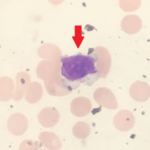
ldutko/shutterstock.com
WASHINGTON, D.C.—As treatments for rheumatoid arthritis (RA) improve, some related conditions that used to be common in patients with RA are not seen very often anymore, but they still exist and physicians need to know how to identify them.
Speaking to attendees at the ACR/ARHP Annual Meeting talk titled Rheumatoid Arthritis—A Case-Based Approach to Selected Extra-Articular Challenges and What You Are Missing with Better Therapies, part of the ACR Review Course, expert Jonathan Coblyn, MD, director of clinical rheumatology at Brigham and Women’s Hospital in Boston, outlined several clinical cases to support his main message. He reviewed cases involving several conditions that newer treatments have made fairly rare: central nervous system (CNS) manifestations of RA, cervical spine involvement, Felty’s syndrome and large granular lymphocyte (LGL) leukemia.
CNS Manifestations in RA
This case involved a 71-year-old man with a long history of RA and pulmonary fibrosis who has been on azathioprine and received a yearly rituximab injection. Two months before being admitted, he’d developed persistent hiccups. A chest X-ray led to treatment of community-acquired pneumonia, after which he did better. But the symptoms returned, and he came back two weeks later with the hiccups again, had lost 30 lbs. and couldn’t swallow liquids or solids.
CNS manifestations of RA include CNS vasculitis; rheumatoid nodules; sterile meningitis and pachymeningitis; infections, including progressive multifocal leukoencephalopathy (PML); hyperviscosity syndromes; cerebrovascular disease; CNS tumors or lymphoma; and effects of medication.
PML has to be a consideration when a patient is on rituximab, but involves neuroimaging that is distinct, meaning that it is limited to the white matter and doesn’t conform to vascular areas as vasculitis would, Dr. Coblyn said. The man was transferred to Brigham and Women’s Hospital.
“He had hiccups that were persistent; that was our clue,” Dr. Coblyn said. A neurologist said that whenever hiccups are involved, attention should be paid to the area postrema, a region in the dorsal surface of the medulla oblongata that lacks the blood–brain barrier and can detect emetic toxins in the brain and the blood. By examining the findings of his magnetic resonance imaging test, they determined that the man had significant inflammation in the area postrema. More studies were done, including flow cytometry of the cerebrospinal fluid, and the man was given broad-spectrum antibiotics and antifungals.
But—as often happens in these cases, Dr. Coblyn said—the diagnosis was made at autopsy. Neuropathology eventually found he had diffuse large B-cell lymphoma, with “notable involvement of basilar leptomeninges by [Epstein-Barr] EBV-virus lymphoma.”



